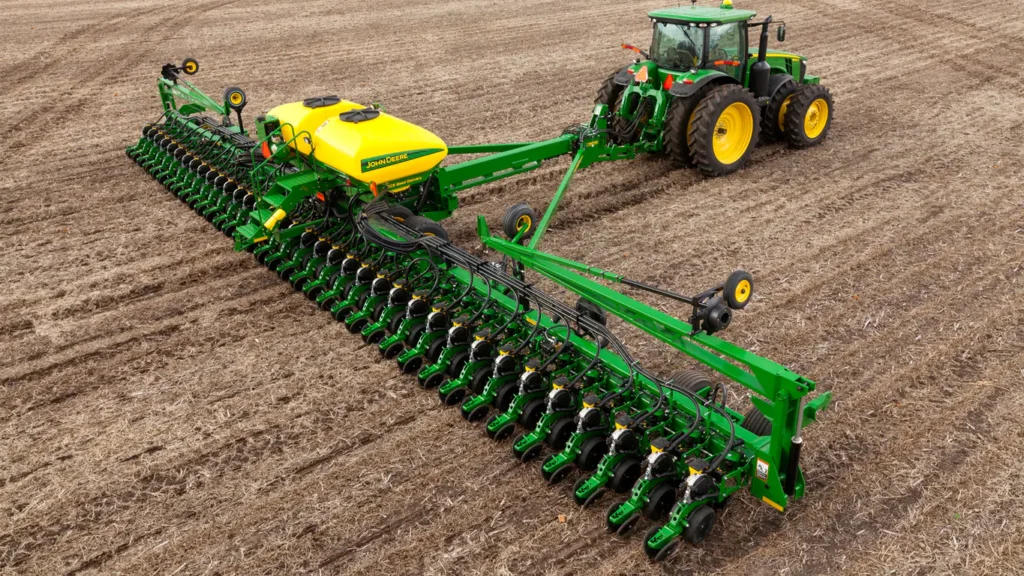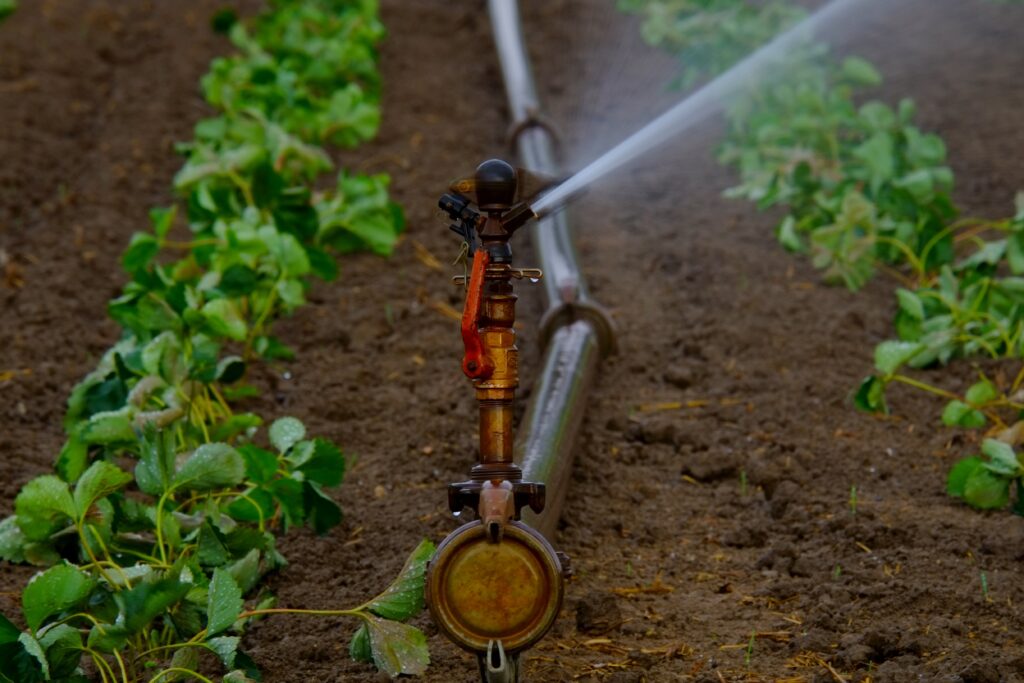Introduction
griculture has always been the foundation of human civilization, providing the essential needs for survival and growth. Over the centuries, agricultural methods have significantly evolved to meet the demands of today’s world, from manual and labor-intensive methods to advanced and more efficient techniques. Today, we are witnessing a technological revolution in agriculture, driven by modern machinery and advanced technologies. This revolution is not just about increasing productivity but also ensuring sustainability, precision, and efficiency in agricultural practices.
This article examines seven key technological advancements that are transforming modern agriculture. First, GPS-equipped tractors are explored, which have redefined farming by enabling precise land mapping, optimal resource use, and time savings. Next, automatic planting machines are reviewed, demonstrating how they can plant seeds with high precision, improving crop conditions and increasing yields.
The third section focuses on the use of drones for crop monitoring, providing real-time data and insights that make farm management easier. Then, no-till planting machines are examined, which preserve soil health and reduce erosion, offering an excellent alternative to traditional tillage methods. Field sensors and IoT devices are covered in the sixth section, discussing their role in providing real-time data for better decision-making.
Finally, smart irrigation systems are reviewed, which optimize water use and improve crop health by delivering water precisely when and where it is needed.
Through detailed scientific explanations, comparisons with traditional methods, real-world examples, and visual data, this article aims to clarify how these modern technologies are transforming agriculture. These innovations that are shaping the future of farming, making it more efficient, sustainable, and productive, will be explored.
GPS-Equipped Tractors

Modern tractors equipped with GPS technology have revolutionized farming methods. GPS, or Global Positioning System, is a satellite-based navigation system that enables precise positioning and accurate data collection. In agriculture, GPS technology is integrated into tractors to enable precision farming. This system aids in accurate land mapping, soil sampling, and crop monitoring. GPS-equipped tractors can follow pre-determined paths with high precision, reducing overlap and missed areas during planting, fertilizing, and harvesting, leading to optimized input use and increased productivity.
Traditional tractors required manual steering and relied on the farmer’s skill to maintain straight lines and even coverage. This often led to inefficiencies like overlapping and missed areas, resulting in wasted resources and time. In contrast, GPS-equipped tractors ensure precision in field operations and significantly reduce human errors. The traditional approach also involved more labor and time, while GPS technology automates many tasks, enabling large-scale and more efficient farming operations.
One notable example of GPS technology in tractors is the John Deere AutoTrac system. This system uses GPS technology to guide tractors with sub-inch accuracy, improving field efficiency by up to 10%. According to a 2023 study published in the Journal of Agricultural and Resource Economics, farmers using AutoTrac reported savings in fuel, seeds, and fertilizers, along with increased crop yields due to better planting precision.
A study by the American Society of Agricultural and Biological Engineers (ASABE) showed that GPS-guided tractors reduce input costs by 10-15% and increase crop yields by 5-8% compared to traditional methods.
Automatic Planting Machines

Automatic planting machines are advanced machines designed to plant seeds with high precision and efficiency. These machines are equipped with advanced technologies like GPS, sensors, and robotic arms that ensure seeds are planted at optimal depth and spacing. Automatic planting machines can adapt to different soil conditions, soil types, and the needs of various crops, leading to uniform germination and growth. These machines can plant multiple types of seeds simultaneously and can adjust their operations based on real-time sensor data.
In the past, the planting process often involved manual planting or simple mechanical planters, which required a lot of human labor and led to inconsistencies in seed placement. These inconsistencies could lead to uneven crop stands, reduced yields, and inefficient use of resources. Manual planting was also time-consuming and physically demanding. In contrast, automatic planting machines operate with remarkable precision and efficiency, significantly reducing the need for manual labor and ensuring uniform seed placement. This leads to better crop stands, higher yields, and more efficient use of inputs like seeds, water, and fertilizers, and also helps farmers manage time more effectively.
One prominent example of automatic planting technology is the John Deere ExactEmerge planter. This machine achieves precise seed spacing and depth control using advanced electric motors and sensors.
Research conducted by Iowa State University in 2023 showed that automatic planters like ExactEmerge can reduce seed waste by up to 10% and improve overall planting efficiency by 25%, resulting in significant cost savings for farmers.
Drones for Crop Monitoring
Drones, also known as unmanned aerial vehicles (UAVs), are increasingly being used for crop monitoring in modern agriculture. These devices are equipped with high-resolution cameras, multispectral sensors, and advanced imaging technologies that provide detailed views of agricultural fields and crops. Drones can collect images and data on crop health, soil conditions, and pests. The data collected by drones is processed using advanced algorithms and software, enabling farmers to make better decisions regarding irrigation, fertilization, and pest control. Drones can cover large areas quickly and provide precise real-time information, which is crucial for precision farming.

Traditional methods of crop monitoring involved manual field inspections and satellite imagery. Manual inspections were time-consuming and often provided limited and inconsistent data. Satellite imagery, although useful, lacked the precision and frequency needed for timely interventions. In contrast, drones provide high-resolution data and enable frequent and accurate monitoring of crop conditions. This leads to more precise and timely decision-making, resulting in better crop management and increased yields.
Research conducted by Purdue University in 2023 showed that drone-based crop monitoring can improve yield prediction accuracy by up to 20% and reduce input costs for fertilizers and pesticides by up to 15%.
No-Till Planting Machines
No-till planting machines are innovative machines designed to plant seeds directly into the soil without prior tillage. This planting method helps preserve soil structure, reduce erosion, and retain organic matter in the soil. No-till planting machines use specialized equipment like coulters and openers to create narrow slots in the soil for seed placement. This technology minimizes soil disturbance and helps retain moisture, leading to better seed germination and growth. Additionally, no-till planting enhances soil biodiversity and overall soil health, which is crucial for sustainable agriculture.

In the past, methods included plowing and turning the soil before planting, which could lead to soil erosion, loss of organic matter, and disruption of soil structure. These methods often required multiple passes over the field, leading to higher fuel consumption and labor costs. In contrast, no-till planting eliminates the need for tillage, significantly reduces soil structure disruption, and preserves soil health. Of course, depending on the crop type and climatic conditions, tillage may still be necessary in some locations. This method also saves time and resources by reducing the number of field operations required. The benefits of no-till planting include improved water retention, reduced erosion, and increased soil fertility, leading to higher and more sustainable crop yields.
One notable example of no-till planting technology is the John Deere 1890 No-Till Drill. This machine is designed for precise seed placement while minimizing soil disturbance. According to a study published in the International Research Journal of Agricultural Science and Soil Science in 2024, farms using this machine experienced a 15% increase in soil organic matter over five years compared to traditional methods. The study also showed that no-till planting reduced soil erosion by 50% and improved water infiltration rates by 25%.
Field Sensors and IoT Devices
Field sensors and Internet of Things (IoT) devices represent the latest advancements in modern agriculture. These technologies involve deploying a network of connected sensors across agricultural fields to collect real-time data on various environmental parameters such as soil moisture, temperature, humidity, nutrient levels, and crop health. IoT devices transmit this data to central systems, where advanced analytics and machine learning algorithms process the information and provide actionable insights for farmers.
Field sensors can include soil moisture sensors, weather stations, nutrient sensors, and plant health sensors. These devices continuously monitor conditions and provide precise, location-specific data. The data collected helps farmers make more informed decisions regarding irrigation, fertilization, pest control, and other critical aspects of crop management. IoT devices ensure that this data is seamlessly accessible from anywhere, enabling remote monitoring and management of fields.
In the past, farmers relied on manual inspections, basic weather forecasts, and occasional soil sampling to make decisions about their crops. This approach often led to reactive rather than proactive management and limited the ability to optimize resource use or respond quickly to changing conditions. Traditional methods lacked the accuracy and real-time capability that modern field sensors and IoT devices offer. In contrast, modern field sensors and IoT devices provide accurate, real-time, and continuous data, enabling proactive and data-driven decision-making.
An example of practical IoT technology is the smart farm network that uses a combination of soil moisture sensors, weather stations, and IoT connectivity to optimize irrigation operations. According to a study published in the Journal of Water Management in 2023, farms using the smart farm network reduced water consumption by 30% while maintaining or improving crop yields. This study highlighted the ability of IoT-based systems to deliver significant water savings and increase overall farm efficiency.
Research conducted by the University of California, Davis, in 2023 showed that integrating field sensors and IoT devices can improve fertilization efficiency by 25% and reduce overall input costs by 20% compared to traditional farming methods.
Smart Irrigation Systems

Smart irrigation systems leverage advanced technology to optimize water use in agriculture. These systems combine soil moisture sensors, weather data, and automated control systems to deliver precise amounts of water to crops based on their specific needs. By continuously monitoring soil conditions and environmental factors, smart irrigation systems can adjust irrigation schedules and volumes in real-time, ensuring that optimal moisture levels are maintained for crop growth.
Smart irrigation systems often use IoT devices, cloud computing, and machine learning algorithms to analyze data and make predictive adjustments. This technology helps reduce water waste, increase crop yields, and promote sustainable water management. Key components of smart irrigation systems include sensor networks, automated valves, weather stations, and data analytics platforms.
Traditional irrigation methods, such as flood irrigation, sprinklers, and manual watering, are often inefficient and can result in significant water waste. These methods typically apply a uniform amount of water across the field, regardless of the different moisture needs of various soil zones or crop growth stages. This can lead to over-irrigation in some areas and under-irrigation in others, resulting in suboptimal crop growth and increased water consumption.
In contrast, smart irrigation systems deliver water precisely when and where it is needed. For example, drip irrigation systems combined with soil moisture sensors can deliver water directly to the root zone of each plant, minimizing evaporation and runoff. Smart irrigation systems can also incorporate weather forecasts and adjust irrigation schedules to prevent unnecessary watering during rainy periods. The result is significantly reduced water consumption, improved crop health, and increased efficiency.
One example of smart irrigation technology is the Netafim Precision Irrigation System. This system integrates soil moisture sensors, weather data, and automated drip irrigation to optimize water delivery. According to a study published in the Journal of Water Management in 2023, the Netafim system reduced water consumption by 40% while increasing crop yields by 15% compared to traditional irrigation methods. This study highlighted the system’s ability to deliver water efficiently and effectively, leading to better resource management and improved agricultural productivity.
Conclusion
The integration of technology and modern machinery in agriculture has ushered in a new era of productivity, precision, and sustainability. From GPS-equipped tractors and automatic planting machines to drones for crop monitoring and smart irrigation systems, these advancements are transforming farming methods. By increasing efficiency, reducing resource waste, and promoting sustainable practices, these technologies address the challenges of modern agriculture and ensure future food security. Embracing these innovations benefits not only farmers but also contributes to the overall health of the environment, paving the way for a more resilient and sustainable agricultural system.


